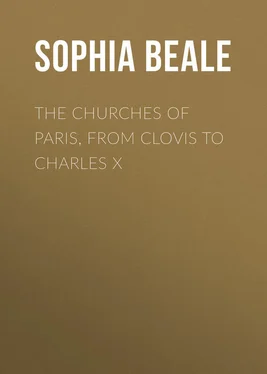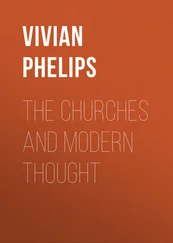Sophia Beale - The Churches of Paris, from Clovis to Charles X
Здесь есть возможность читать онлайн «Sophia Beale - The Churches of Paris, from Clovis to Charles X» — ознакомительный отрывок электронной книги совершенно бесплатно, а после прочтения отрывка купить полную версию. В некоторых случаях можно слушать аудио, скачать через торрент в формате fb2 и присутствует краткое содержание. Жанр: foreign_antique, foreign_prose, на английском языке. Описание произведения, (предисловие) а так же отзывы посетителей доступны на портале библиотеки ЛибКат.
- Название:The Churches of Paris, from Clovis to Charles X
- Автор:
- Жанр:
- Год:неизвестен
- ISBN:нет данных
- Рейтинг книги:3 / 5. Голосов: 1
-
Избранное:Добавить в избранное
- Отзывы:
-
Ваша оценка:
- 60
- 1
- 2
- 3
- 4
- 5
The Churches of Paris, from Clovis to Charles X: краткое содержание, описание и аннотация
Предлагаем к чтению аннотацию, описание, краткое содержание или предисловие (зависит от того, что написал сам автор книги «The Churches of Paris, from Clovis to Charles X»). Если вы не нашли необходимую информацию о книге — напишите в комментариях, мы постараемся отыскать её.
The Churches of Paris, from Clovis to Charles X — читать онлайн ознакомительный отрывок
Ниже представлен текст книги, разбитый по страницам. Система сохранения места последней прочитанной страницы, позволяет с удобством читать онлайн бесплатно книгу «The Churches of Paris, from Clovis to Charles X», без необходимости каждый раз заново искать на чём Вы остановились. Поставьте закладку, и сможете в любой момент перейти на страницу, на которой закончили чтение.
Интервал:
Закладка:
Of the early kings of France Dagobert was the first to be buried at S. Denis, and his memorial tomb (much restored) still stands on the right of the High Altar. Clovis and Clotilde were buried in the crypt of the first church erected upon the site of S. Geneviève, then called the Church of the Holy Apostles. Childebert was laid in the church of the Abbey of S. Vincent (founded by him), afterwards called S. Germain-des-Près. Chlodoald was buried at S. Cloud; S. Radegonde, wife of Clotaire I., at Poitiers; Chilpéric and Frédégonde laid the body of one of their children in the first church of S. Denis. Besides Dagobert I., his queen, Nanthilde, and their sons, Sigebert II. and Clovis II. were buried at S. Denis; and although it is thought that other Merovingian princes also received burial there, many repose at Chelles, S. Waast d'Arras, S. Bertin, S. Etienne de Choisy, Metz, Angoulême, S. Romain de Blaye, Jumièges, and S. Crépin de Soissons. The monuments of Charles-Martel, Pépin and Berthe, Carloman, Charles the Bald, Ermentrude, Louis, Carloman, and Eudes were all at S. Denis. Charlemagne was buried at Aix-la-Chapelle, where the magnificent châsses containing his skull and some of his bones may still be seen. His descendants were distributed all over Europe: at Köln, Mainz, Prüm, Regensburg, Loresheim, Oettinghen, Reichenau, Audlau, Verona, Milan, and Piacenza; those in France, at Metz, Sens, Bourges, S. Laurent, S. Sulpice, Tours, Angers, Lyon, Portiers, Compiègne, Reims, Péronne, and Soissons.
From Hugues Capet to Louis XV. most of the kings were interred at S. Denis; but it must be borne in mind that almost all the tombs of the earlier sovereigns are modern, either wholly or in part. In the 13th century the strange custom came into fashion of dividing the bodies of royal personages, and burying the parts in different places. The Benedictine monks of S. Denis protested against this division of valuable property, asserting their right to possess the entire remains of the kings; but the Dominicans and the Cordeliers contested these claims, and subsequently gained permission for their own churches to share in the spoil. Later on, other religious orders obtained the same privileges; and the ladies of Val-de-Grâce were distinguished by the possession of the hearts of nearly all the royal princes and princesses from Anne d'Autriche, the founder of the monastery. Naturally, when each defunct sovereign was divided into three portions – the body, the heart, and the intestines – great opportunities were afforded to architects and sculptors; and we thus find three marble monuments with recumbent figures erected for the remains of Charles V., that at S. Denis containing his body, while Rouen and Maubuisson respectively possessed his heart and his et ceteras . 19 19 This custom of dividing bodies is of very ancient date, and was sanctioned by the church in order that the remains might benefit, by their miraculous powers, as many places as possible. Sometimes the superiors of divers monasteries agreed to exchange "a rib of one saint for a cubit bone of another, an eye for an eye, a tooth for a tooth, &c." At other times these fragments had to be purchased for very considerable sums. — History of St. Denis.
Francis I.'s heart was placed in an exquisite urn in the church of the nuns of Haute-Bruyère; while his body was buried in the grand monument at S. Denis. The urn was the work of Pierre Bontems, and is now in the same chapel as the tomb, which was the joint work of Philibert Delorme and Bontems. The beautiful group of the Three Graces , by Germain Pilon, formerly in the church of the Célestins, and now in the Renaissance Museum of the Louvre, supported an urn containing the heart of Henri II.; 20 20 The original urn was cast in bronze by Benoist Boucher from the design of Domenico da Firenze, who also designed the relief on the pedestal.
the hearts of the 13th and 14th Louis, enveloped in shrines in the form of silver Angels, being the property of the church of the Jesuits. The number of monuments erected at S. Denis to the memory of the families of the sovereigns was small; and none of them were to be compared, as works of art, to the beautiful tombs of the Dukes of Bourgogne and of Brétagne at Dijon, at Bruges, and at Nantes. Most of the princes of the different families, the Condés, the Contis, the Valois, the Bourbons, &c., had founded chapels or monasteries where they were afterwards buried; as, for instance, the Orléans chapel at the Célestins, which was celebrated for its magnificence. 21 21 Some of its sculptures are now in the Renaissance Museum of the Louvre. The recumbent alabaster statue of Philippe de Chabot, by Jean Cousin; a white marble column and three Genii, by Etienne Lehongre, from the tomb of Louis de Cossé, duc de Brissac, and of his brother, J. A. de Cossé; a column with allegorical statues, &c., in bas relief, by Prieur Barthélemy, from the monument erected for the reception of the heart of Anne de Montmorency; sepulchral Genii, by Jean Cousin, from the tomb of Philippe de Chabot; a Fortune, by the same sculptor and from the same tomb; sepulchral monument of the Ducs de Longueville, by François Anguier; and the recumbent statue of Anne de Bourgogne, daughter of Jean-sans-Peur, wife of the Duke of Bedford. In the same museum of the Louvre is a bas-relief from S. Denis of the 14th century with traces of colour, the subject being the three martyrs, SS. Denis, Rusticus, and Eleutherius.
None of the monuments of the early kings are anterior to the 13th century; consequently, even the original portions of the effigies which remain cannot be looked upon as in the slightest degree portrait statues. On the other hand, the magnificent tombs in bronze, and the brasses which adorned them, erected to the memory of Philippe Auguste, S. Louis, and his father, and which were destroyed centuries ago, were most probably as valuable as contemporary portraits as they were for their workmanship; likewise the 13th century effigies which remain are remarkable for the beauty of their workmanship. Louis IV. was the last prince who was laid under a simple stone monument. The last tomb erected was that of Henri II., the sovereigns who followed him having had no memorials. They were laid together in one great crypt, and when disturbed by the Revolutionists for the sake of the lead of their coffins ("of the coffins of our old tyrants let us make bullets to hurl at our enemies"), there were fifty-four bodies arranged upon iron trestles side by side, Henri IV. 22 22 Henri IV. also abjured "his accursed heresy" at S. Denis.
heading the list, and the Dauphin, elder son of Louis XVI., ending it. The monuments now occupy the same position that they did before the Revolution; and if we stand upon the raised platform of the apse behind the High Altar we can gaze down upon what may be called the history of France, from the artistic point of view, during four or five centuries. On the left, the 13th century tomb of Dagobert stands erect; beyond it, the Renaissance mausoleum of Francis I., one of the chefs-d'œuvres of that grand sculptor, Philibert Delorme. On the right, the enamelled brasses of the children of S. Louis and the tomb of Henri II. A mosaic effigy of Frédégonde, the Orléans monument, and the tomb of Louis XII. by the brothers Juste, of Tours, complete the list of important works, while all about are recumbent figures upon arcaded monuments. The resting-places of the abbots were simply marked by inscriptions or flat slabs. The historian of the Abbey, Dom Michel Félibien, records the number of thirteen stones of grand priors with effigies, besides the abbots' tombs.
Among the distinguished men buried at S. Denis were the following: —
Pierre Chambellan, of whom Joinville writes, "Messire Pierre Chambellan fut le plus loial homme et le plus droicturier que je veisse oncques en la maision du roi … l'homme du monde en qui le roy croirit plus"; and Alphonse, son of Jean de Brienne, King of Jerusalem and uncle of S. Louis, whose epitaph designates him as "moult saige et moult loial chevaliers." Both of them died "au service de Dieu et de Monsieur Loys, roy de France, dessous Cartaige l'an de l'incarnation de Nostre-Seigneur MCCLXX," and were "enterrés en l'église Monsieur Saint Denis" in the year MCCLXXI, "le vendredi devant la Penthecoste le jour et l'heure quand Monsieur le roy Loys fut enterré"; indeed, the old chronicler says, "aus pieds du bon roys tout en la manière qu'il gisoit à ses pieds quand il estoit en vie." Pierre accompanied S. Louis in the disastrous crusade which terminated his reign. No doubt his tomb was of metal, destroyed with many others long before the Revolution, as for example, that of the Comte d'Eu, in gilt copper, enriched with enamels, which succumbed to the greed of the Huguenots.
Читать дальшеИнтервал:
Закладка:
Похожие книги на «The Churches of Paris, from Clovis to Charles X»
Представляем Вашему вниманию похожие книги на «The Churches of Paris, from Clovis to Charles X» списком для выбора. Мы отобрали схожую по названию и смыслу литературу в надежде предоставить читателям больше вариантов отыскать новые, интересные, ещё непрочитанные произведения.
Обсуждение, отзывы о книге «The Churches of Paris, from Clovis to Charles X» и просто собственные мнения читателей. Оставьте ваши комментарии, напишите, что Вы думаете о произведении, его смысле или главных героях. Укажите что конкретно понравилось, а что нет, и почему Вы так считаете.




![Theresa Cheung - The Dream Dictionary from A to Z [Revised edition] - The Ultimate A–Z to Interpret the Secrets of Your Dreams](/books/692092/theresa-cheung-the-dream-dictionary-from-a-to-z-r-thumb.webp)







